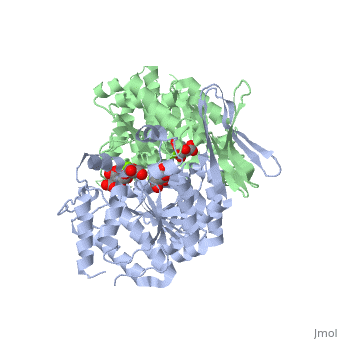2uxr
From Proteopedia
Complex with isocitrate and the protein isocitrate dehydrogenase from the psychrophilic bacterium Desulfotalea psychrophila
Structural highlights
FunctionEvolutionary ConservationCheck, as determined by ConSurfDB. You may read the explanation of the method and the full data available from ConSurf. Publication Abstract from PubMedIsocitrate dehydrogenase (IDH) has been studied extensively due to its central role in the Krebs cycle, catalyzing the oxidative NAD(P)(+)-dependent decarboxylation of isocitrate to alpha-ketoglutarate and CO(2). Here, we present the first crystal structure of IDH from a psychrophilic bacterium, Desulfotalea psychrophila (DpIDH). The structural information is combined with a detailed biochemical characterization and a comparative study with IDHs from the mesophilic bacterium Desulfitobacterium hafniense (DhIDH), porcine (PcIDH), human cytosolic (HcIDH) and the hyperthermophilic Thermotoga maritima (TmIDH). DpIDH was found to have a higher melting temperature (T(m)=66.9 degrees C) than its mesophilic homologues and a suboptimal catalytic efficiency at low temperatures. The thermodynamic activation parameters indicated a disordered active site, as seen also for the drastic increase in K(m) for isocitrate at elevated temperatures. A methionine cluster situated at the dimeric interface between the two active sites and a cluster of destabilizing charged amino acids in a region close to the active site might explain the poor isocitrate affinity. On the other hand, DpIDH was optimized for interacting with NADP(+) and the crystal structure revealed unique interactions with the cofactor. The highly acidic surface, destabilizing charged residues, fewer ion pairs and reduced size of ionic networks in DpIDH suggest a flexible global structure. However, strategic placement of ionic interactions stabilizing the N and C termini, and additional ionic interactions in the clasp domain as well as two enlarged aromatic clusters might counteract the destabilizing interactions and promote the increased thermal stability. The structure analysis of DpIDH illustrates how psychrophilic enzymes can adjust their flexibility in dynamic regions during their catalytic cycle without compromising the global stability of the protein. Structural and functional properties of isocitrate dehydrogenase from the psychrophilic bacterium Desulfotalea psychrophila reveal a cold-active enzyme with an unusual high thermal stability.,Fedoy AE, Yang N, Martinez A, Leiros HK, Steen IH J Mol Biol. 2007 Sep 7;372(1):130-49. Epub 2007 Jun 19. PMID:17632124[1] From MEDLINE®/PubMed®, a database of the U.S. National Library of Medicine. See AlsoReferences
| ||||||||||||||||||||


